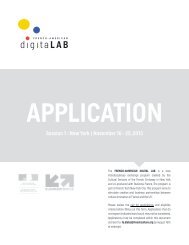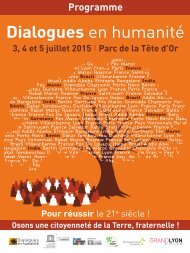REX
BD16_REX
BD16_REX
Create successful ePaper yourself
Turn your PDF publications into a flip-book with our unique Google optimized e-Paper software.
Retours d’expériences Big Data en entreprise<br />
variations. Buildings also vary in age, with generations of local architectural adaptations made over time. Then<br />
there are the occupants — a mix of people with unique activities and comfort thresholds. Understanding how all<br />
these factors mesh together requires historical data and data analysis. A lot of it.<br />
These are complex and critical problems we’re trying to solve. And cloud and machine learning technology is<br />
helping us push boundaries of what is possible in ways I couldn’t have imagined a few years ago. — Azizan Aziz,<br />
Senior Research Architect<br />
THE DATA CHALLENGE MEETS THE DATA SLEUTHS<br />
Making all the captured data from buildings work together is like putting together a massive jigsaw puzzle. Some<br />
buildings on campus, such as the Gates Center, have hundreds of sensors, and others not so many. These sensors<br />
are tracking CO2 levels in different rooms, measuring the distribution of temperatures by floor, by room and by<br />
height, monitoring windows, lighting systems and plug loads. And there’s more: People who work inside make up<br />
the most significant part of a building’s heartbeat — so user satisfaction data is being added to the mix based on<br />
occupant surveys in order to have a holistic picture of the indoor environmental quality of the workplace.<br />
To say it’s a complex task would be putting it lightly. Lasternas and Aziz spend a good deal of time being data<br />
sleuths, and finding ways to listen to what the buildings are trying to communicate — the story that lives in the data.<br />
There is a real difference you can make in energy conservation by giving people data that is actionable instead of<br />
asking them to just do their best — Bertrand Lasternas, Senior Researcher<br />
When Lasternas came to Carnegie Mellon from France in 2010, he was a physics and chemistry major working<br />
towards a master’s degree in mechanical engineering and building sciences. Today, he’s an expert in extracting<br />
data from building management systems and sensors, both to understand how buildings work, as well as to help<br />
people manage energy more efficiently.<br />
Recalling challenges from the earlier phases of the research, Lasternas says, “We might have 10 different manufacturers<br />
of equipment in a single building, and none of them share information. So how do you pull all of that<br />
together? We wanted to empower people to be more engaged in the living building, more aware of their energy<br />
usage patterns.”<br />
With help from Microsoft’s Global ISV partner OSIsoft, Lasternas and Aziz began using their solution, the PI System,<br />
four years ago. It offered the missing “glue” that helped the team bring data together from various sources,<br />
“cleanse” it, store it in a common, usable format, and make it ready for historical and real-time analysis. The PI<br />
System supports more than 400 interfaces that can connect to systems from the many different vendors of building<br />
systems and controls.<br />
THE MACHINE LEARNING BREAKTHROUGH<br />
“We’re not trained data scientists. We went overnight from using complex statistical analysis tools to drag-n-drop<br />
insights. That’s a breakthrough for the work we do” — Senior Researcher Azizan Aziz<br />
Having conquered the data integration and storage challenge, the team dove into analysis — a world of massive<br />
spreadsheets and programming languages such as MATLAB to handle big, iterative computations. It was an<br />
exercise that very quickly got unwieldy. “We’re not trained data scientists by background, and complex statistical<br />
packages are outside of our immediate area of expertise,” says Aziz.<br />
“One of our former students was using MATLAB for analysis,” he recalls. “It took her a long time just to prepare and<br />
sort the data, and then a single run of analysis took 30-45 minutes. That’s far too long to develop good predictions<br />
for demand reduction. We really need to do these iterative analyses in real-time.”<br />
Machine Learning, cloud and data visualization technologies changed the dynamics of their project dramatically.<br />
“With Azure Machine Learning, the time it took to run a single experiment went from 45 minutes to instantaneous,”<br />
Aziz says. “It’s really fun to be able to use multiple types of machine learning algorithms and just have the results<br />
appear immediately. We’re able to play with all the variables and make sense of which ones contribute most to a<br />
specific change in building conditions.”<br />
LETTING THE DATA TELL THE STORY<br />
To let the data tell its own story in a way that is visual and easy to grasp, the Carnegie Mellon researchers build<br />
“digital dashboards” that make data anomalies much easier to spot. Using these dashboards, they’ve been able to<br />
solve puzzles in the buildings they’re working on. In one case, Lasternas recalls, “We saw an unusual area of low<br />
temperature in a building and realized that someone was leaving a window open in the middle of winter, when it<br />
was minus-eight degrees outside.”<br />
According to Aziz, when a strange condition is spotted on the dashboard, the solution is often a simple one. “We<br />
ask people why they have the boiler on when the temperature outside is 85 degrees. Turns out they didn’t know it<br />
was on, because they don’t have the data presented to them clearly,” he says.<br />
Having data-based insight on-the-fly is great, but where things get really interesting is with the potential to do predictive<br />
modeling. This is an area where cloud and machine learning technologies have truly been a game changer.<br />
Because Carnegie Mellon is collecting and storing real-time and historical data on campus buildings using the PI<br />
System, they finally have the ability to do predictive analysis using Azure Machine Learning in exciting ways.<br />
For people who live in buildings and use its systems, providing data alone isn’t enough to change behavior. “People<br />
need to see the impact of their actions every minute. Digital dashboards often trigger the “aha!” moments.”<br />
— Lasternas<br />
One of the team’s early experiments involved trying to figure out the ideal time to ramp up the heating in campus<br />
buildings to hit 72 degrees at start of business (by 8 a.m.), given predicted variations in outdoor temperature and<br />
sunshine. Using Azure Machine Learning, they built a model that looked at months of “heat up” data from the building’s<br />
records and matched that to multi-day external temperatures and anticipated solar radiation. The result? They<br />
were able to zero in on a custom model for each day to start heating a building at the lowest energy use.<br />
“As simple as that victory sounds, the implications for energy and dollar savings are simply enormous —especially<br />
when you scale up,” notes Lasternas. For this group of researchers, the potential to scale up such predictive ca-<br />
Document réalisé par la Société Corp Events - Janvier 2015<br />
65







